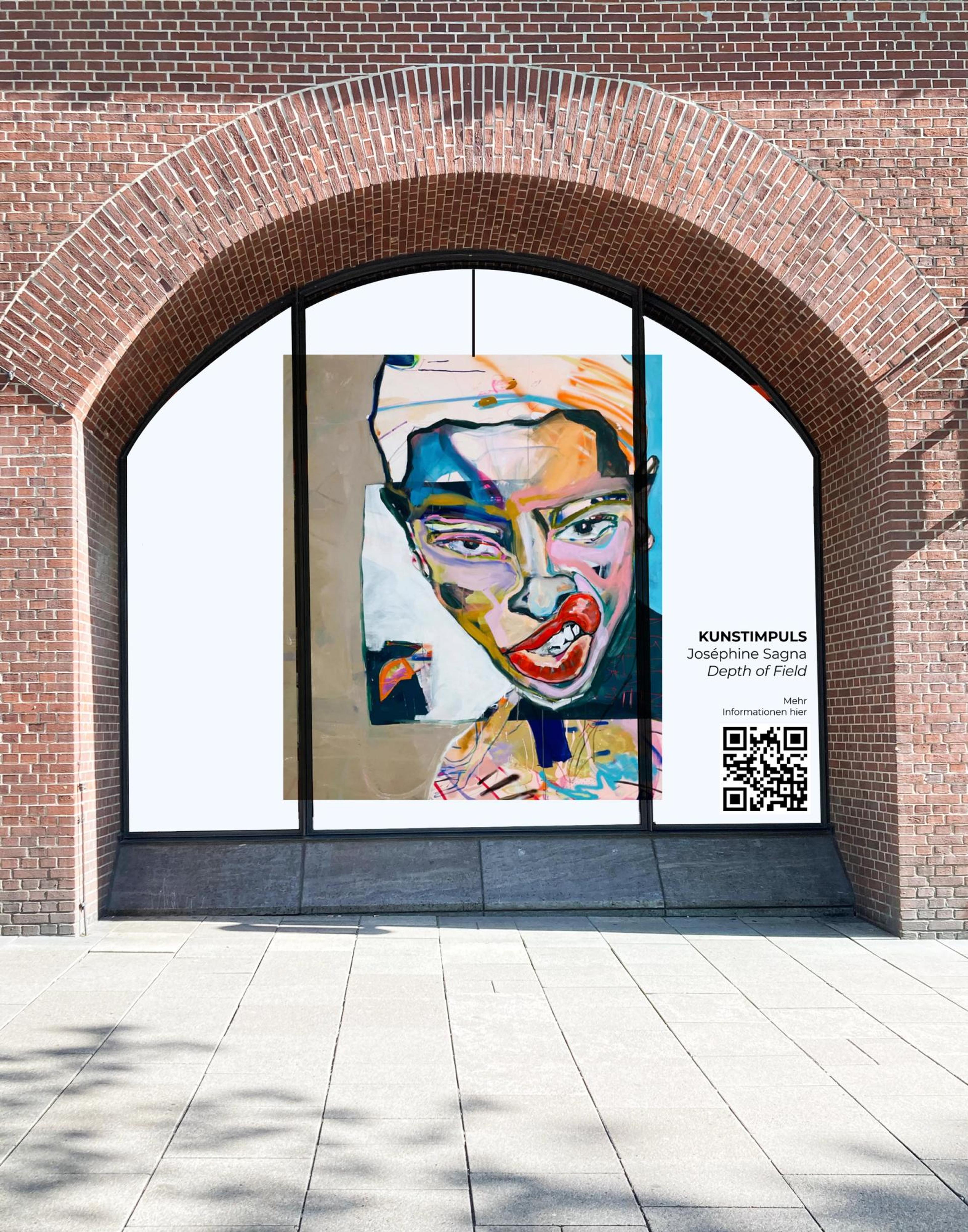Art impulses on Mönckebergstraße
Nine artists from the MeetFrida Foundation will be setting new art impulses on Mönckebergstrasse with a window exhibition starting on May 19. They show the creative potential in the Mönckeberg district and set an example for the integration of art and culture in the city center.
The exhibition will run from May 19 until September 2023 and will occupy the entire frontage to Mönckebergstraße as well as parts of Lange Mühren. It gives the former Galeria Kaufhof building, which will be completely renovated and rebuilt by 2025, a new art reference. In the middle of Hamburg's city center, the 2m x 3m prints on display show a wide range of explorations of artistic work processes and inspirations, sending out artistic impulses that invite visitors to stop and linger.
This is an initiative of the MeetFrida Foundation and Tishman Speyer.
In formal design, Darko Caramello Nikolic is influenced by Op and Urban Art and Suprematism. His work is consistently conceptual in nature and abstract in character. The artist is inspired by patterns and structures of any kind, in any place. He is found and touched by them, gladly unexpected and unsought. In content, he likes to orient himself on philosophical questions of the Enlightenment. To pose these questions again, in the form of a painting, is an exciting way for him to approach new solutions and to develop his own aesthetics from them.
Every painting is a journey, at the beginning you don't know how long or difficult it will be. But once it has begun I go through the process until the picture comes to a standstill in front of my eye and the journey is finished. It happens that you are euphoric and happy or pull your hair out because you doubt, ponder and fail, touch your own limits of what is feasible for you and your own being. But the most important thing for me is to walk the path until silence sets in, in my senses and in my spirit.
Simone Karl
Simone Karl's collages are centrally concerned with themes of feminist and queer corporeality. Although the human form is always present as a key organic figure, the boundaries of the corporeal are fluid. Not only do skin, hair, fabrics, crystalline forms and the environment merge into one another - even the binary gender characteristics become ambiguous, contradicting a constant request by the viewerln for binary classification. A hybrid of bodily characteristics emerges, which is neither woman nor man, but above all an organism. The purely external becomes less relevant and the innermost literally turns inside out, regardless of gender. The collage itself becomes an organic object. With layered holes into the interior, topographical surfaces, and a physical growth into the exterior, the works, which are primarily created from queer magazines, reflect the diversity of physical and gender possibilities.
Malwin Faber creates complex synergies of gestural traces, sharp-edged cutouts, lines and material textures. The abundance of different, interwoven colors and forms initially seems like a Gordian knot that demands the viewer's full attention. Faber relies on a fascinating interplay of seemingly contradictory images and outwardly opposing prominence: the small-scale with the large-scale, geometric elements contrasted with sweeping indexical signs, convergence with centrifugal force. Most striking is the simultaneity of speed and stillness, of chance and precision. The gradual composition of the painting resembles a jazz improvisation; it is a mixture of freedom and discipline with changing rhythms.
In the works of Sibylle Mayr one can get to know life forms that seem at the same time strange and yet familiar, sprung from the sea, man or Mars. Creatures and organs reveal connections and make the non-self-evident visible. Sibylle Mayr prefers to engage with formal duplicities, created to show essential drives of life. In the most recent series of works, she again emphasizes man's constant effort to bring the wildly moving outside inside, to collect it, to possess it, perhaps to tame it. The hopelessness of this enterprise is told through the blurring of the living and the almost plastic emergence of the tool from the image.
Sibylle Mayr works as a visual artist in Hamburg. The artistic focus is now on oil painting and installation. Her works have been shown in Germany, Austria, Israel, Costa Rica and New Zealand. She was selected as an exchange artist from her first hometown for the twin city in Israel, and last year (2022) she received the summer scholarship from the city of Hamburg and the Roger Willemsen Stiftung.
Joséphine Sagna is a German-Senegalese artist and designer born in Stuttgart, Germany, now living in Hamburg. She allows her multi-ethnic identity to flow deeply into her artistic work. Her work focuses primarily on multicultural, black and female experiences in a predominantly white society. Sagna's art discusses and addresses prejudice, everyday racism, reactions, different ways of seeing, whether from one's own eye or the eyes of others, intimacy and self-expression, but also where Sagna sees herself in the midst of it all. Her works are captivating with bright colors and a vibrant, expressive style.
Although her painterly approach is rooted in a figurative tradition, she breaks away from limiting notions and allows the abstract to inform her creative process.
The artist's idea is to symbolize the view of an amorphous mass of people in a pulsating metropolis with the countless fragmented silhouettes that make up his paintings: Superficially, billowing shapes, lines, and colors reveal themselves. Only when one delves deeper does the particular, the individual in a scenario, become apparent. In doing so, David Friedemann breathes life into his ephemeral figures with a variety of materials and textures, creating countless captivating, albeit fleeting, counterparts for the viewer.
A small oval, a few powerful lines - that's all it takes for the viewer to recognize a human being in seemingly random strokes and shapes. Whether these figures hidden in David Friedemann's paintings reveal themselves to the eye and what scenarios they represent depends entirely on the one who seeks them. On his mood of the day, his dreams and memories. It is quite possible that today, when looking at the picture, a couple lying on the meadow will show itself to him, which tomorrow - in a different mood - will already be invisible again.
Marie Mewes was born in New York, studied graphic design in Düsseldorf and now lives as an artist in Hamburg. Painting for Marie is like an experimental journey. She prefers to paint with acrylic, she loves the rich colors. Partly she combines painted with glued on her pictures. She captures people/moments/impressions and lets them flow through her, transforming them into something new. Her intention is to touch with her paintings.
Klara Schoell is a painter from Hamburg. Her painting is a game between preservation and destruction, an interaction of different emotional states. This manifests itself in many layers and transparencies on the canvas, creating its own unique color tone. A painting often accompanies the artist over a longer period of time. Klara Schoell begins a picture intuitively, abstractly and expressively. only after a few painting sessions she begins to bring developed areas into an order and to commit to a concrete image motif. She shows sensitive moments from her life, which invite to associate their own experiences.
BEKANNT AUS
Stay up to date
Register now for Frida's newsletter and don't miss a thing - exclusive discounts, new items, current projects and much more!

We use cookies to make your experience on our website pleasant and to improve it!
Your cart is empty














